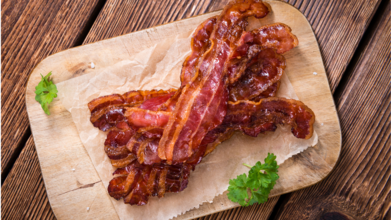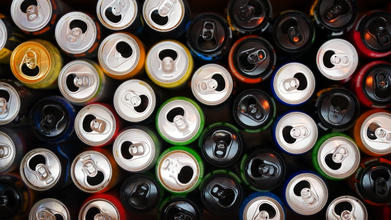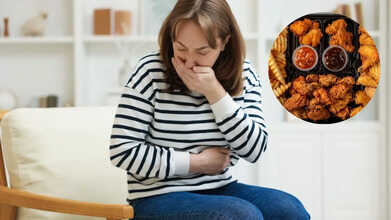- Health Conditions A-Z
- Health & Wellness
- Nutrition
- Fitness
- Health News
- Ayurveda
- Videos
- Medicine A-Z
- Parenting
Why a Top Gut Doctor Says Bacon Should Be Banned from Breakfast Plates

Credits: Canva
If you think the worst thing on your breakfast plate is sugar in your cereal or the butter on your toast, think harder. According to Dr Alan Desmond, gut health specialist and author, the worst thing is processed food and he wishes the world could wave goodbye to it forever. Referring to bacon, the crispy, salty, beloved slice that makes brunch plates look complete, he says that it may also be shortening lives by the hundreds of thousands.
Why Bacon Is the Bad for Health
Dr Desmond does not mince words when it comes to processed meats. Bacon, sausages, salami, pepperoni, ham, hot dogs and other smoky foods may taste divine, but their health record is worse than you might imagine. These meats are not just linked to bowel cancer, a risk factor many already know, but also to heart disease, type 2 diabetes and premature death. In fact, global health experts estimate that processed meats contribute to over 644,000 preventable deaths each year. To put it simply, that tasty strip in your pan may be costing society more than just a few clogged arteries.
Why Doctors Never Say “Pass the Bacon”
Unlike most people, Dr Desmond admits he has never felt tempted to have bacon at breakfast. The science, in his view, is clear that regular consumption of processed meats is dangerous, and avoiding them entirely is one of the simplest dietary decisions you can make to protect your health. In an age where everyone is chasing superfoods and longevity hacks, giving up bacon might sound boring, but it could be one of the most effective moves for your long-term wellbeing.
Also Read: 101-Year-Old Harvard Doctor's Secrets To Live A Longer, Healthier Life
Ultra-Processed Foods and Cancer Risk
Ice cream, breakfast cereal, and that quick-fix instant noodle packet might save a lot of your time and satisfy your taste buds. But a growing body of research suggests they may be doing more harm than just expanding your waistline. A new study has drawn a strong link between eating ultra-processed foods (UPFs) and a significantly higher risk of developing lung cancer.
Here is what you need to know about the findings and whether your daily diet might be putting your lungs at risk.
The study, led by Chinese researchers and published in the medical journal Thorax, tracked the health and food habits of over 100,000 American adults, with an average age of 63, for around 12 years. Using detailed dietary questionnaires, researchers zoomed in on the intake of UPFs, which include all your guilty pleasures: cakes, cookies, soft drinks, frozen pizzas, hot dogs, margarine, sugary cereals, and yes, even your beloved salty snacks.
Participants consumed anywhere between half a serving to six servings of these foods daily, with the average landing at nearly three servings a day. Lunch meats and soft drinks came out on top as the most commonly consumed items.
Also Read: This Surprisingly Simple Sleep Reset Works Better Than Any Hack
By the end of the study, 1,706 participants had developed lung cancer. When researchers compared diets, a disturbing pattern emerged: those who ate the most UPFs had a 41 per cent greater chance of developing lung cancer compared to those who ate the least.
It is Not Just About Smoking
Naturally, the study controlled for smoking status, an obvious and major risk factor for lung cancer. But the researchers admit they could not account for smoking intensity, a variable that could skew results. Still, the pattern remained strong even when separating out different lung cancer types, including both small cell and non-small cell variants.
Reports say that a quarter of lung cancer cases occur in non-smokers, and this highlights the need to explore other possible triggers, including diet.
However, the study is not airtight. Dietary habits change a lot over 12 years, and participants only logged their UPF intake at the start.
What is the Study Actually Saying?
The study’s authors are not claiming that UPFs cause lung cancer. But the association is strong enough to spark concern. They say global efforts to cut back on ultra-processed foods could be an effective way to reduce lung cancer cases, especially among non-smokers.
They are not wrong. While the direct line between a cupcake and a cancer cell has not been proven, UPFs are already known to contribute to obesity, heart disease, type 2 diabetes, and even depression. Adding lung cancer to the list, even with some scientific caveats, raises the stakes for rethinking what is on your plate.
Vaping May Be Rising, But Smoking Is Falling
On a related note, separate research from the University of Michigan offers a silver lining: teenage smoking is on the decline. Tracking data on 16- and 17-year-olds in Britain from 1974, 1986, and 2018, the study showed a drop from 33 per cent to 12 per cent in teen smoking. But in 2018, 11 per cent of teens reported using e-cigarettes instead.
That is still a win in the long-term fight against lung cancer, but it also makes lifestyle-related risks like diet more significant. If fewer people are smoking, then other contributors to lung cancer, like poor nutrition, could become even more important to understand.
Should You Panic or Not?
The science is not settled, and researchers are being cautious. Still, the message is clear: even if you have never lit a cigarette in your life, what you eat might be silently setting off alarms in your body.
While more studies are needed to confirm causation, this new research adds to a growing chorus warning us about the dangers of overly processed meals. You do not need to quit cake completely, but maybe it is time to take care of your lungs more by making better food choices.
Can You Consume Energy Drink Daily? This Is What The Experts Say

Credits: iStock
Energy drink is linked with stroke risk was found out when a fit 54-year-old man suffered stroke. Previously Health and Me also reported about the man, a non-smoker and non-drinker, who suffered stroke, thanks to his habit of consuming energy drinks. The doctors found his blood pressure to be sky rocketing. His left side of the body was weak, he lost balance, had trouble walking and speaking.
Another similar case comes from Canada, where a 10-year-old also suffered a seizure, consuming just two energy drinks in the week.
Experts are now weighing in if it is at all safe for anyone to consume energy drink.
Read: How Energy Drinks Nearly Killed a Healthy 54-Year-Old Runner
Energy Drink: Are They Safe To Consume?
As per the Food and Drug Administration (FDA), energy drinks are "pure and highly concentrated caffeine products can have serious health consequences, including death."
A BMJ study from 2025, Energy drinks, hypertension and stroke, found high morbidity and mortality rates associated with stroke and cardiovascular disease linked to high-sugar drink consumption.
Energy Drink: What Do experts Think Of Its Safety?
Speaking to wmur.com, Dr Raj Dasgupta, a board-certified physical who specializes in internal medicine, pulmonology critical care, and sleep medicine said, "Caffeine is a stimulant, which means it increases activity in your brain and nervous system."
Caffeine keeps us awake by blocking adenosine, the brain chemical responsible for making us feel drowsy. Energy drinks boost alertness and focus partly by increasing adrenaline levels, though how strong the effects feel and how long they last can vary based on the person and the amount of caffeine consumed.
What Makes Energy Drinks Different From Coffee?
The short answer is that it depends. The energy drink market is huge, and there is no one-size-fits-all comparison. That said, many energy drinks do contain more caffeine per serving than a regular cup of coffee.
An average 8-ounce cup of brewed coffee has about 95 to 100 mg of caffeine. Energy drinks, on the other hand, can range widely, often providing anywhere between 70 and 200 mg per serving. The actual impact depends on how much you drink and how your body responds to caffeine.
Where The Caffeine In The Energy Drink Comes From Matters
Not all caffeine is created equal. The source can influence the drink’s overall nutritional value.
Some natural sources, like green tea, come with added benefits such as antioxidants and trace minerals. Ingredients like guarana and yerba mate also contain natural compounds that may support mood and energy levels. In contrast, highly processed or artificial caffeine sources usually do not offer these extra benefits.
The Sugar Problem Of Energy Drinks
One of the biggest differences between coffee and energy drinks is sugar. Coffee can be customized, so you control how much sugar goes in. Many energy drinks, however, are loaded with added sugar.
For example, a single 16-ounce can of some popular energy drinks can contain over 60 grams of sugar, well above the recommended daily limit. Some brands use artificial sweeteners instead, which research has linked to a higher risk of heart disease and stroke over time.
How Safe Are Energy Drinks?
Health experts agree that moderation is key, regardless of your caffeine source. Most healthy adults can safely consume up to 400 mg of caffeine per day.
Too much caffeine can cause shakiness, poor sleep, a racing heartbeat, headaches, or stomach issues. Over time, excessive intake can also lead to dependence, meaning you need more caffeine to feel the same effect.
Who Should Be Extra Careful Before Consuming Energy Drinks?
Certain people should be more cautious with energy drinks. Caffeine can worsen anxiety and interfere with sleep, especially for those already struggling with these issues. People with heart conditions may also need to limit or avoid caffeine since it can raise heart rate and blood pressure.
While labels may highlight antioxidants or added supplements, the high sugar, caffeine, and preservatives often cancel out these benefits. The same nutrients can be found more reliably in whole foods like fruits and vegetables.
Can Ozempic Trigger Nausea After Greasy Meals? Doctor Weighs In

Credits: Canva
As the use of anti-obesity medicines like Ozempic continues to grow, more people are trying to understand what daily life looks like on these injections. Beyond weight loss results, concerns often centre on side effects, especially those linked to digestion. Many users of GLP-1 agonist medicines report gastrointestinal issues such as nausea, vomiting, constipation, and heartburn. In recent months, another pattern has caught attention. Several people say they feel sick after eating greasy or oily food.
To understand why this happens, we spoke to Dr Pratayksha Bhardwaj, World Record Holder Dietician and Weight Management Specialist, who explains that this reaction is more common than people realise.
What Ozempic Does Inside the Body
Ozempic, medically known as semaglutide, was originally developed to help manage Type 2 diabetes. It is now widely prescribed for weight management because of how it influences appetite and digestion.
According to Dr Bhardwaj, Ozempic works by slowing down gastric emptying and acting on appetite-regulating centres in the brain. “Food stays in the stomach longer, and the feeling of fullness comes earlier than usual,” he explains. This change helps people eat less but also alters how the body handles certain foods.
Why Greasy Food Can Trigger Nausea On Ozempic
Fatty and oily foods naturally take longer to digest. When this process is further slowed by Ozempic, the stomach can struggle to cope with heavy meals.
Dr Bhardwaj says that eating large portions, especially foods high in fat, can overwhelm the digestive system. “When fatty foods sit in the stomach for too long, they can trigger nausea, vomiting, or even diarrhoea,” he notes. This is why some people feel unwell shortly after eating fried snacks, fast food, or rich gravied dishes.
Is This an Allergy or Something Else?
Many patients worry that vomiting after eating greasy food might be a sign of an allergic reaction. Dr Bhardwaj clarifies that this is not the case. “This response is physiological, not allergic,” he says. It reflects how the body adapts to the medication rather than an intolerance to the drug itself.
Clinically, doctors observe that tolerance for oily foods drops sharply after starting Ozempic. Vomiting is more commonly reported during the early stages of treatment or when the dose is being gradually increased.
Can This Side Effect Be Beneficial?
Interestingly, this reaction can support healthier eating habits. Dr Bhardwaj points out that the discomfort acts as a natural reminder to change food choices. Patients are often advised to eat smaller portions, reduce fat intake, and include more fibre-rich vegetables in their meals.
Lower-fat foods are easier to digest and less likely to cause nausea. Over time, many people find that their preferences shift away from heavy, greasy meals.
When to Seek Medical Advice?
While occasional nausea can be expected, persistent vomiting should not be ignored. Dr Bhardwaj advises consulting a doctor if symptoms continue. In some cases, a dose adjustment or personalised nutrition plan may be needed to reduce discomfort while continuing treatment safely.
Ozempic can be effective, but understanding how it interacts with food is key to managing side effects and maintaining long-term health.
The Diet That Changed Lionel Messi: The Five Foods That Power The Footballer At 38

Credits: Instagram
Lionel Messi is here in India and is ready for his touch down in Delhi on December 15 as part of his GOAT (Greatest of All Time) Tour's India visit. Argentina's World Cup-winning captain is also set to visit Hyderabad after his visit in Delhi, for now, he has met his fans in Mumbai and Kolkata. All things said and done, what every one is always curious about is a sports person's fitness regime. The 38-year-old football star undergoes a strict fitness regime, which includes consistency, but it is not based on heavy lifting, but agility training, and a simple not-too-fancy diet.
However, his fitness journey was not traditional in any manner. In fact, during his early years, he was known for eating without much of a thought. So, what changed him? What is his secret to a fit life?
How Messi Changed His Eating Habits To Stay Fit
In 2013-14 World Cup, which was disappointing for Messi, ESPN India reported that Messi improved his performance by adapting a new diet. Charly Rexach, the then FC Barcelona's sporting director, who signed the then 13-year-old Messi to the club in 2000 on a napkin, said that Messi had previously "eaten too many pizzas".
In an interview to America TV's La Cornisa, Messi admitted about his eating habits and poor diet, which had even led to bouts of vomiting, nausea, and even lethargy. The footballer said, "I don't know what I ate, but I ate badly for many years. At 22, 23...[it was] chocolate, alfajores [South American sandwich cookies], fizzy drinks."
It was nutritionist Giuliano Poser who helped Messi make changes in 2014. His diet was nothing fancy, nothing too difficult, but it was controlled.
Five Pillars Of Messi's New Diet
Messi's new diet was based on five pillars:
- Water
- Olive oil
- Whole grains
- Fruits
- Vegetables
Messi also shared in an interview, "Now I eat well: fish, meat, vegetables, salads. Everything is organized and taken care of. Sometimes a bit of wine, but that's not a problem."
This diet helped him reduce inflammation and recover his muscles faster. When it came to avoiding certain foods Poser stressed the importance of eating little sugar and refined flour. Poser called these two "the worst thing for the muscles". "The farther he stays away from sugars, the better. Refined flours are also a big problem as these days, it’s difficult to find uncontaminated wheat.”
Water
Studies published in the Journal of Athletic Training and Journal of Physical Therapy Science, show that dehydration increases markers of muscle damage and inflammation after exercise. Research also notes that adequate hydration supports blood flow and nutrient delivery, which are essential for muscle repair.
Olive oil
Research in Nature and the Journal of Nutritional Biochemistry highlights that extra virgin olive oil contains oleocanthal and polyphenols, compounds shown to have anti-inflammatory effects similar to mild anti-inflammatory drugs, helping reduce muscle soreness and inflammation.
Whole grains
According to studies in the American Journal of Clinical Nutrition, whole-grain intake is associated with lower levels of C-reactive protein, a key marker of inflammation. Their complex carbohydrates and magnesium content support muscle function and recovery after physical activity.
Fruits
Research published in Nutrients and Sports Medicine shows that antioxidant-rich fruits like berries and citrus help reduce oxidative stress caused by exercise, which can otherwise delay muscle recovery and increase inflammation.
Vegetables
Large observational studies, including reports in The BMJ, link high vegetable intake with reduced systemic inflammation. Their vitamins, minerals, and phytochemicals support immune response and tissue repair, aiding post-exercise muscle recovery.
What Does Messi's Workout Regime Look Like? 3s Of Messi's Fitness
As per reports, Messi's training is not as rigorous as players like Neymar and Cristiano Ronaldo, but it does not mean that there is not consistency. In fact, his primary training focuses on three factors:
- Speed
- Strength
- Stretching
The footballer’s fitness does not come from heavy weightlifting. Instead, it is built on a balanced routine that focuses on strength training, agility, speed, extensive stretching, and overall muscle health. His workouts include short, explosive sprints, bounding drills like hurdle hops and pillar skips, all aimed at keeping his body sharp, responsive, and match-ready.
© 2024 Bennett, Coleman & Company Limited

